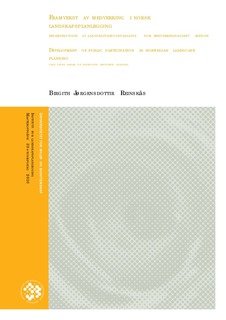| dc.description.abstract | SAMANDRAG
Utgangspunktet for denne masteroppgåva er å finne svar på kvifor og korleis ein legg opp til medverking i norsk landskapsplanlegging. Gjennom teori og eksempelstudie freistar eg å finne
svar på problemstillinga. Oppgåva startar (kapittel 2) med skildring av kva medverking er; ulike
grader av medverking, kven som kan medverke og forskjellen på aktiv og passiv deltaking.
Vidare i oppgåva blir framveksten av medverking framstilt, med fokus på overgangen frå
instrumentell til kommunikativ planlegging. Oppgåva presenterar overgangen til kommunikativ
planlegging som ein reaksjon på og ei misnøye med, den ekspertbaserte planleggingsretninga
instrumentell planlegging. Dette har vore tema for ein internasjonal diskusjon sidan slutten av
1950- talet og fram til i dag. Norsk planlegging er påverka av den internasjonale debatten og
framveksten av medverking, og det har gjort seg synleg i lovverk og planleggingsmetodar.
I kapittel 3 freistar eg å framstille korleis medverking er synleg gjennom føringar i forvaltning av
landskap, med fokus på plan- og bygningslova (PBL) frå 1985 og 2008, og to internasjonale
konvensjonar; Rio-konvensjonen og den europeiske landskapskonvensjonen. Oppgåva ser også
på korleis kravet om medverking i PBL blir truga av privatinitiert planlegging, som også er
heimla i same lovverk. Når det gjeld konvensjonar som har hatt tyding for auka merksemd på
medverking som tema, er det særleg den europeiske landskapskonvensjonen eg fokuserar på.
Denne konvensjonen har hatt ei særskilt tyding for eksempelstudiet mitt.
Oppgåva legg vekt på framveksten av medverkingsbaserte analysemetodar (kapittel 4), gjennom
eit konkret eksempel; landskapsressursanalyse. Dette eksempelstudiet synleggjer oppgåva
korleis ein i praksis legg opp til medverking i landskapsplanlegging. Landskapsressursanalysen
er utgangspunktet for kapittel 5, og grunnlaget for SWOT -analysen og vurderinga i kapittel 6.
SWOT- analysen fokuserar på styrkar, veikskapar, moglegheiter og truslar med
landskapsressursanalysen som prosess og produkt, særleg på bakgrunn av empiri frå
landskapsressursanalysen – ”Telemarkskanalen som regionalpark”.
Mot slutten av oppgåva drøftar eg landskapsressursanalysemetoden i ljos av teori og empiri, og
nokre av tema som blir tatt opp er: 1)Høveleg plassering av metoden i modellen over
planleggingstradisjonar, utarbeidd av Friedmann(1987), og på medverkingsstigen til Arnstein
(1969). 2) Om landskapsressursanalysen tilfredstiller krav om aktiv medverking i den
europeiske landskapskonvensjonen, og korleis utelating av aktiv medverking i ny plan- og
bygningslov kan vere ein trussel for medverking. 3) Tydinga av å ha ei klar definering av kva
slags medverking det er ein legg opp til; symbolsk eller reell. 4) Korleis bør metoden vere,
korleis kan han gjerast betre og kva er framtidsutsiktene for metoden? Avslutningsvis blir det
5
konkludert med at metoden bør nyttast av fagkyndige som både har fagkunnskapen og er gode
prosesskoordinatorar. Metoden er eit naudsynt bidrag til landskapsplanlegginga, og er særeigen
med sitt stadkjenslearbeid, eit opplegg der folk flest blir involvert, i tråd med
landskapskonvensjonens siktemål og landskapsdefinisjon. ABSTRACT
The main issues in this thesis are to find reasons why public participation became a part in
landscape planning, and in which way we can see public participation in the Norwegian
landscape planning today. The problem as presented will be discussed employing basic theory
and a case study. This thesis describes participation as a term in planning subjects, with
different degrees of participation, and it describes who could participate and the differences
between active and passive participation. Subsequently, the development of participation with
the focus on the change from instrumentell to communicative planning is presented.
Communicative planning is presented as a reaction and a displeasure to instrumental planning
merely based on experts. This has been the subject of international debate since the end of
1950s until today. Norwegian planning is being influenced by the international debate and the
development of participation, which clearly comes into view in the Norwegian legal systems and
in planning methods.
This thesis also describes how participation comes into view in regulation for landscape. I focus
on the Planning and Building Act from 1985 and 2008 and two international conventions; the
Rio-convention and the European Landscape Convention. This thesis looks at the claim of public
participation in the Planning and Building Act, and how the claim could be threatened by private
initiated planning, also with legal authority in the same legal system. The European Convention
is particularly covered in the thesis due to it`s significance in the case study.
The development of analysis methods based on participation is emphasized in the thesis, and a
particular example on landscape resource analysis is provided. The case study illustrates how
public participation is set up in practical landscape planning. The landscape resource analysis
method forms the basis of chapter five, and the SWOT- analysis and subsequent evaluation of
chapter six. The SWOT analysis focuses on strengths, weaknesses, opportunities and threats
with the landscape resource analysis as a process and a product. Empiricism from a process in
Telemark with a preparation of a landscape analysis named as; “Telemarkskananlen som
regionalpark”.
At the end of the thesis a discussion on the landscape resource analysis method based on theory
and empiricism is provided. The topics include: 1)Suitable position of the method in a model
with planning traditions, prepared by Freedman (1987), and at the ladder of citizen
participation, prepared by Arnstein (1969). 2) Whether the landscape resource analysis meet
the demands of active participation in the landscape convention, and how the omission of the
active term in the Planning and Building Act could present a threat for the public participation.
7
3.) The importance of having a clear definition of what kind of participation the process set up
for is also discussed, and also how the method should be, what has to be modify and how is the
future prospect? At the end I draw a conclusion about the need for specific skills to use the
method; expert knowledge and process coordination skills. This method is an essential
contribution to landscape planning, and the characteristic work with “sense of place” that
involved the ordinary man and woman, such as the aim in the European Landscape Convention
and its definition of landscape. | en_US |
